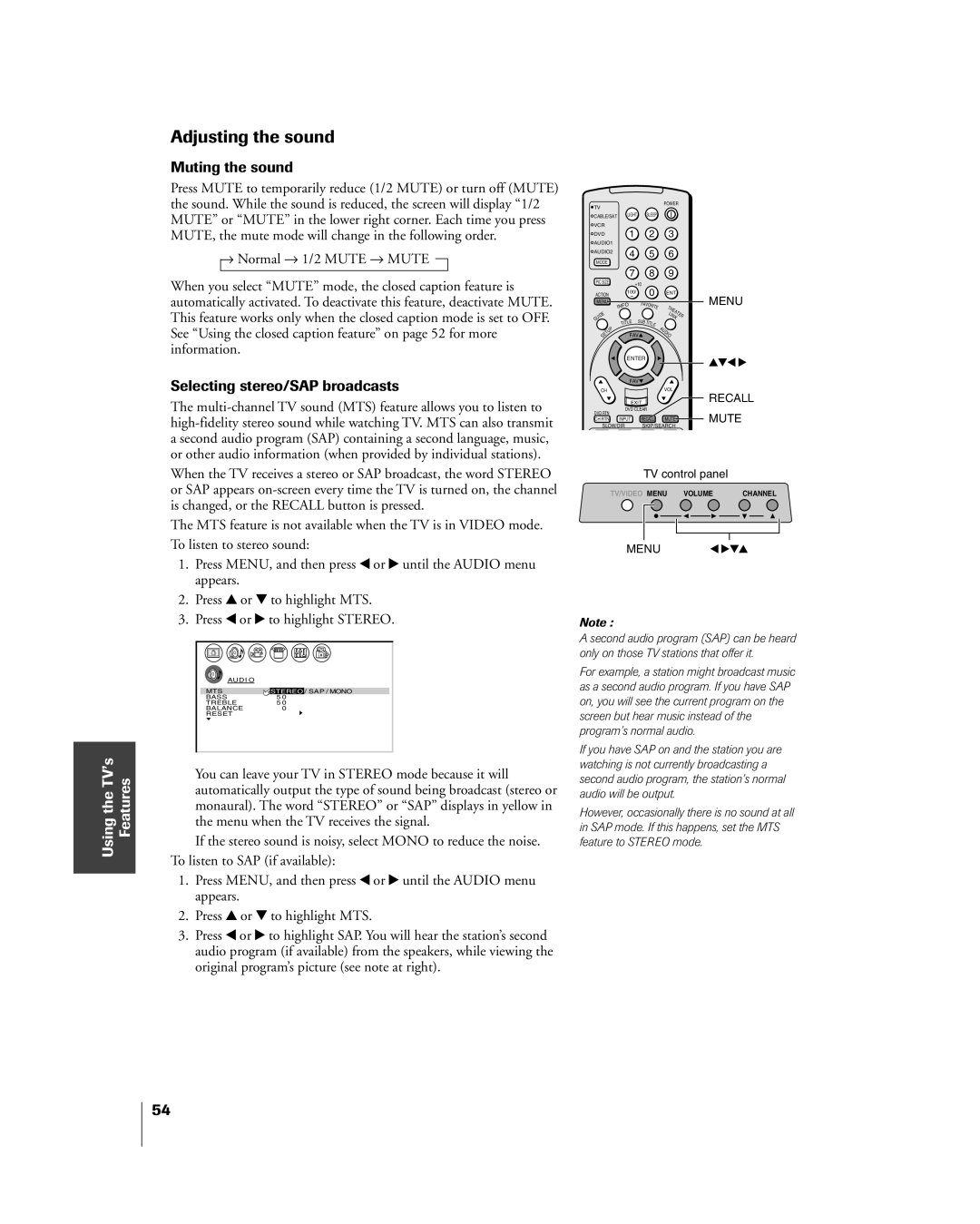
Using the TVÕs Features
Adjusting the sound
Muting the sound
Press MUTE to temporarily reduce (1/2 MUTE) or turn off (MUTE) the sound. While the sound is reduced, the screen will display Ò1/2 MUTEÓ or ÒMUTEÓ in the lower right corner. Each time you press MUTE, the mute mode will change in the following order.
→Normal → 1/2 MUTE → MUTE
When you select ÒMUTEÓ mode, the closed caption feature is automatically activated. To deactivate this feature, deactivate MUTE. This feature works only when the closed caption mode is set to OFF. See ÒUsing the closed caption featureÓ on page 52 for more information.
Selecting stereo/SAP broadcasts
The
When the TV receives a stereo or SAP broadcast, the word STEREO or SAP appears
The MTS feature is not available when the TV is in VIDEO mode. To listen to stereo sound:
1.Press MENU, and then press x or • until the AUDIO menu appears.
2.Press y or z to highlight MTS.
3.Press x or • to highlight STEREO.
AUD I O |
|
MTS | STEREO / SAP / MONO |
BASS | 5 0 |
TREBLE | 5 0 |
BALANCE | 0 |
RESET |
|
You can leave your TV in STEREO mode because it will automatically output the type of sound being broadcast (stereo or monaural). The word ÒSTEREOÓ or ÒSAPÓ displays in yellow in the menu when the TV receives the signal.
If the stereo sound is noisy, select MONO to reduce the noise. To listen to SAP (if available):
1.Press MENU, and then press x or • until the AUDIO menu appears.
2.Press y or z to highlight MTS.
3.Press x or • to highlight SAP. You will hear the stationÕs second audio program (if available) from the speakers, while viewing the original programÕs picture (see note at right).
TV |
|
|
|
| POWER |
|
| ||
|
|
|
|
|
|
|
|
| |
CABLE/SAT | LIGHT |
| SLEEP |
|
|
|
|
| |
|
|
|
|
|
|
|
| ||
VCR |
|
|
|
|
|
|
|
|
|
DVD |
| 1 |
| 2 | 3 |
|
|
| |
AUDIO1 |
|
|
|
|
|
|
|
|
|
AUDIO2 |
| 4 |
| 5 | 6 |
|
|
| |
|
|
|
|
|
| ||||
MODE |
|
|
|
|
|
|
|
|
|
|
| 7 |
| 8 | 9 |
|
|
| |
PIC SIZE |
| +10 |
|
|
|
|
|
| |
|
| 0 |
|
|
|
|
| ||
ACTION |
| 100/ |
| ENT |
| MENU | |||
MENU |
| NFO | FAVORI | T |
|
| |||
| I |
| TE |
|
|
|
| ||
|
|
|
|
| HE |
|
|
| |
E |
|
|
|
| LI | AT |
|
| |
|
|
|
|
| E |
| |||
ID |
|
|
|
| N |
| R |
| |
U |
|
|
|
|
| K |
|
|
|
G |
| LE | SUB | TIT |
|
|
|
|
|
|
|
|
|
|
|
| |||
|
| TIT |
|
|
|
|
|
| |
|
|
|
| LE |
|
|
|
|
|
P |
|
|
| A |
|
|
|
| |
U |
|
|
|
| U |
|
|
|
|
T |
| FAV |
| DI |
|
|
|
| |
SE |
|
| O |
|
|
|
| ||
|
|
|
|
|
|
|
|
| |
|
| ENTER |
|
|
|
| yzx • | ||
|
|
|
|
|
|
|
| ||
|
| FAV |
|
|
|
|
|
| |
CH |
|
|
|
| VOL |
|
| RECALL | |
|
| EXIT |
|
|
|
| |||
DVD RTN |
| DVD CLEAR |
|
|
| MUTE |
| ||
|
|
|
|
|
|
|
| ||
CH RTN |
| INPUT | RECALL | MUTE |
|
| |||
SLOW/DIR | SKIP/SEARCH |
|
|
| |||||
|
|
| TV control panel |
| |||||
TV/VIDEO MENU |
|
| VOLUME | CHANNEL | |||||
|
| MENU |
|
|
| x •zy | |||
Note :
A second audio program (SAP) can be heard only on those TV stations that offer it.
For example, a station might broadcast music as a second audio program. If you have SAP on, you will see the current program on the screen but hear music instead of the program’s normal audio.
If you have SAP on and the station you are watching is not currently broadcasting a second audio program, the station’s normal audio will be output.
However, occasionally there is no sound at all in SAP mode. If this happens, set the MTS feature to STEREO mode.
54
